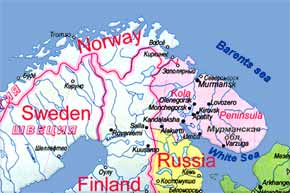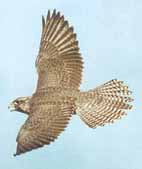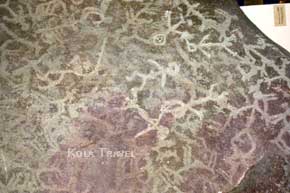|
| |
  |
|
| |
  |
 The Kola Peninsula is the northernmost territory of European Russia, situated
north of the 66th Parallel. The territory extends 550 kilometres from west to
east, and 400 kilometres from north to south. The Peninsula is bordered by the
White Sea in the southeast and by the Barents Sea in the north and northeast. Karelia lies to the south, Finland to the west, and Norway to the northwest.
The Kola Peninsula is the northernmost territory of European Russia, situated
north of the 66th Parallel. The territory extends 550 kilometres from west to
east, and 400 kilometres from north to south. The Peninsula is bordered by the
White Sea in the southeast and by the Barents Sea in the north and northeast. Karelia lies to the south, Finland to the west, and Norway to the northwest. The region is covered by tundra, forest-tundra and taiga (dense forest) and is
home to a wide variety of flora: more than 650 species are found here. Trees
include three types of spruce, four types of birch, as well as pine, rowan, and
alder. The Kola Peninsula is also rich in fauna. Wildlife includes reindeer and
elk, brown bear, wolf, fox, Arctic fox, ermine, and wolverine; birds include
wild geese, duck, ptarmigan, hazel-hen, grouse, eider and peregrine falcon.
Various representatives of the salmon family can be found in plenty in the lakes
and rivers. The "King-Fish" (pink salmon) leaps through river rapids on its
journey from sea to spawning ground. The Kola Peninsula boasts more than 130,000
lakes and rivers.
The region is covered by tundra, forest-tundra and taiga (dense forest) and is
home to a wide variety of flora: more than 650 species are found here. Trees
include three types of spruce, four types of birch, as well as pine, rowan, and
alder. The Kola Peninsula is also rich in fauna. Wildlife includes reindeer and
elk, brown bear, wolf, fox, Arctic fox, ermine, and wolverine; birds include
wild geese, duck, ptarmigan, hazel-hen, grouse, eider and peregrine falcon.
Various representatives of the salmon family can be found in plenty in the lakes
and rivers. The "King-Fish" (pink salmon) leaps through river rapids on its
journey from sea to spawning ground. The Kola Peninsula boasts more than 130,000
lakes and rivers. A number of mountain ranges rise out of the western and central parts of the
Kola Peninsula. The largest of these is the Khibiny Tundra, possessing a maximum
elevation of 1200m (Mt. Judychvumchorr). The Lovozero Tundra is made up of
rounded mountains with plateau summits, the highest point being Mt.
Angvundaschorr at 1127m. Both the Khibiny and the Lovozero Tundra are rich in
exotic minerals. Jewel-like lakes, transparent springs, majestic waterfalls,
fantastic rock outcrops and stunning mountain vistas can be found in these
regions. At lower elevations, virgin forests stretch for huge distances.
A number of mountain ranges rise out of the western and central parts of the
Kola Peninsula. The largest of these is the Khibiny Tundra, possessing a maximum
elevation of 1200m (Mt. Judychvumchorr). The Lovozero Tundra is made up of
rounded mountains with plateau summits, the highest point being Mt.
Angvundaschorr at 1127m. Both the Khibiny and the Lovozero Tundra are rich in
exotic minerals. Jewel-like lakes, transparent springs, majestic waterfalls,
fantastic rock outcrops and stunning mountain vistas can be found in these
regions. At lower elevations, virgin forests stretch for huge distances. The first inhabitants of the Kola Peninsula arrived over 10,000 years ago.
Remains of ancient civilisations have been found here, with the earliest finds
thought to date from the Mesolithic Period. Petroglyphs were discovered on the
banks of the Panoy River, one of the Peninsula’s longest rivers. These paintings
are the oldest memorials of rock art among ancient peoples. For ages people
continued to come to this sacred spot, and painted more and more pictures. The
Petroglyphs depict the life and religious symbolism of the region’s inhabitants;
however, many questions remain unanswered regarding their origin and the people
who created them.
The first inhabitants of the Kola Peninsula arrived over 10,000 years ago.
Remains of ancient civilisations have been found here, with the earliest finds
thought to date from the Mesolithic Period. Petroglyphs were discovered on the
banks of the Panoy River, one of the Peninsula’s longest rivers. These paintings
are the oldest memorials of rock art among ancient peoples. For ages people
continued to come to this sacred spot, and painted more and more pictures. The
Petroglyphs depict the life and religious symbolism of the region’s inhabitants;
however, many questions remain unanswered regarding their origin and the people
who created them.